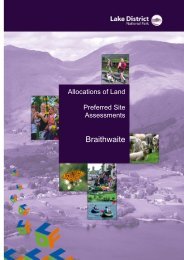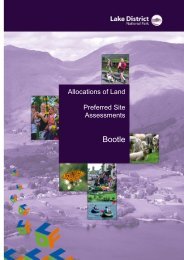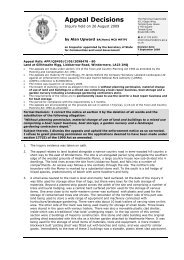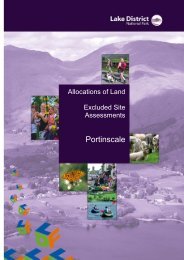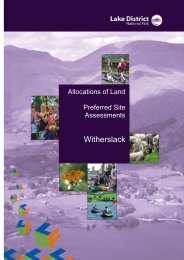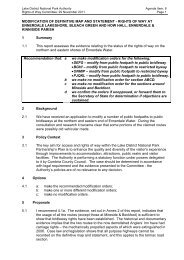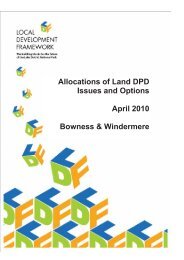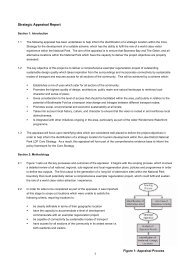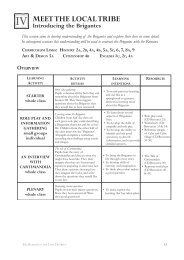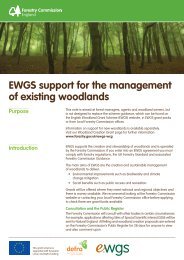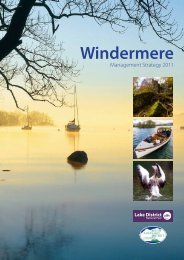The Partnership's Plan - Lake District National Park
The Partnership's Plan - Lake District National Park
The Partnership's Plan - Lake District National Park
Create successful ePaper yourself
Turn your PDF publications into a flip-book with our unique Google optimized e-Paper software.
<strong>The</strong> Government’s ‘<strong>The</strong> Big Society’ initiative should support voluntary groups to run post<br />
offices, libraries, transport services and shape housing projects. <strong>The</strong> Eden Valley has been<br />
identified as one of four areas in the country to take forward the concept. <strong>The</strong> project area will<br />
be given an expert organiser and dedicated civil servants to ensure ‘people power’ initiatives<br />
get off the ground. Initiatives being championed include a local buy-out of a rural pub, efforts to<br />
recruit volunteers to keep museums open, support to speed up broadband supply, and giving<br />
residents more power over council spending.<br />
3.9.4 Key partners<br />
Most importantly, the communities themselves. But key partners in the <strong>Lake</strong> <strong>District</strong> include<br />
the <strong>National</strong> <strong>Park</strong> Authority, Cumbria Association of Local Councils, Action with Communities<br />
in Cumbria, Local Town and Parish Councils, <strong>District</strong> Councils, Cumbria County Council, Local<br />
Strategic Partnerships, Neighbourhood Policing Teams and Neighbourhood Forums.<br />
3.10 Housing<br />
3.10.1 Facts and challenges<br />
• Adequate housing to meet existing and future need is critical for vibrant and<br />
sustainable communities. <strong>The</strong> <strong>National</strong> <strong>Park</strong> profile (Annex B) contains information<br />
about the current housing stock. <strong>The</strong>re is also more detail within the Cumbria Housing<br />
Strategy (2006/11) and the Local Development Framework.<br />
• Housing sustains individual settlements and hamlets but also preserves the character<br />
of places. An area with a declining local population will lose its local distinctiveness and<br />
its links with cultural heritage.<br />
• <strong>The</strong>re has been a significant increase in the ratio between earnings and house prices<br />
across the area. <strong>The</strong> Government recommends that the ideal ratio for income to house<br />
price is between 2.9:1 and 3.5:1, depending on whether it is a single income or dual<br />
income. In the Central <strong>Lake</strong>s Housing Market Area this ratio is 13.6:1. Young people<br />
and newly formed households cannot afford to buy on the local housing market, and<br />
they leave. In some places this is particularly stark and must be reversed to help<br />
maintain and support our communities.<br />
• <strong>The</strong> central <strong>Lake</strong> <strong>District</strong> has some of the highest house prices in England and the<br />
lowest wages. <strong>The</strong> demand for new affordable housing units is the issue. In contrast<br />
the west, influenced by the Energy Coast Masterplan, demand is for higher<br />
specification accommodation. We cannot escape the issue of an ageing population and<br />
the challenge of providing homes for a changing population.<br />
• According to the Cumbria Housing Strategy there are 7,374 second homes in Cumbria,<br />
the majority – 4,136 - are concentrated in and around the <strong>Lake</strong> <strong>District</strong> and Yorkshire<br />
Dales <strong>National</strong> <strong>Park</strong>s. <strong>The</strong> Strategy has developed a set of indicators to measure the<br />
balance of each of the housing market areas in Cumbria. <strong>The</strong>re are nine measures and<br />
the one specific to second homes says ‘When second homes form 10 per cent or more<br />
of the market, this appears to affect the sustainability of any village’.<br />
• <strong>The</strong>re is an issue emerging related to the ageing population. As younger people leave<br />
and only richer households are able to buy property for retirement or second<br />
homes/holiday lets the percentage of older households will increase. This affects the<br />
balance of the communities but the challenge will also be to support households who<br />
find themselves increasingly isolated. <strong>The</strong>re is currently no workable mechanism to<br />
tackle this issue.<br />
49



